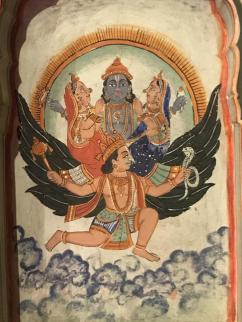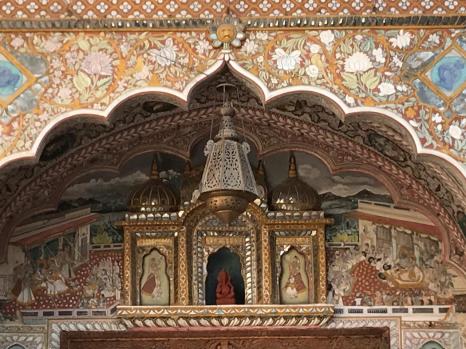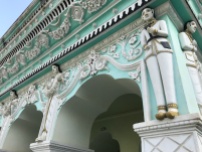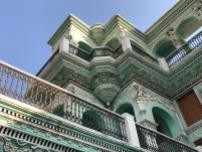Welcome aboard! You are on a time travel device. And, are advised to hold tight, keep your jaws from dropping and eyes from popping out as Aparna Andhare, the maverick pilot, swooshes you through the lanes and by-lanes of Shekhawati in north east of Rangeelo Rajasthan.
The region of Shekhawati is probably one of the most colourful in Rajasthan and offers a chance to explore the lifestyles of a powerful, influential and prosperous merchant and business community. Names of havelis and families who own them will seem familiar, and guides will rattle off top industrialists’ names, lamenting that the owners now live in Bombay, and visit only too rarely. These profusely painted havelis have been called open ‘art galleries’, and are a treat for a traveller interested in art and culture.

The havelis were built in the 18th and 19th century, and some have been turned into museums, others only have a watchman and a small family taking care of the place. Taking care is loosely translated into collecting tickets, showing people around, and sweeping the place occasionally. Most havelis are in decrepit conditions, and need urgent EXPERT conservation, if they’re to last, even a few more years. There are a handful hotels, which sustain the maintenance of these large rambling mansions, but come with a different set of problems— modernising facilities, adding air conditioning, invasive restorations, to name a few. With depressing facts out of the way, let us now travel to a handful of these havelis.
The trip began from Jaipur, on a Friday afternoon, and I hoped to be back in time for dinner on Sunday. The weekend would take us on a whirlwind trip – Nawalgarh, Dhundload, Mandawa, Fatehpur, Ramgarh, and Churu. If you have the time, I’d recommend going to more places – Mahansar, Alsisar, Sikar, Bissau, Lacchmangarh, Samode, perhaps even visiting more havelis in the towns you stop at 🙂
We set off from Jaipur and drove straight to Nawalgarh, reaching Roop Niwas Kothi in time for tea. As we drove through the very small roads, we caught our first sight of the havelis— painted façades, stucco work, and far too many animals on the street. Roop Niwas is a small property, very comfortable, and comes attached with a massive stable. Dropping art historical ambitions, we spent the evening with horses, and a quiet dinner.
Starting early, we had a guide take us to a few Havelis in Nawalgarh— best among which are the Morarka and Poddar Havelis, now museums. The“Frieda Kahlo” mural will be teased, and they claim the image is old, mixing up dates to a while before she was born.
The structure of most havelis include a courtyard as you enter, with two rooms on the side for conducting business, and receiving guests. Family and more privileged visitors are invited inside, where there are more courtyards and rooms, as well as the kitchen and stores. Narrow staircases will lead upstairs, and a balcony looks over the courtyards, which are typically open to the sky. Bigger havelis will have several of these central courtyards surrounded by rooms, and more steps will lead to the terrace. Climb up for the view, as well as decorative stucco sculptures, roof and window flourishes.
The havelis are painted in several registers and images are chosen carefully for their location. It’s easy to be overwhelmed with the range of visual material: floral design, animals, deities, tales of the Ramayana and the Mahabharata, and scenes from daily life— modernism is captured with trains and cars. Portraiture is also a favourite theme. Of course, the number of artworks on the walls is daunting and a casual viewer is most likely overwhelmed.
We went to Dhundlod and spent the afternoon in Mandawa, where we went to Gulab Rai ki Ladia, a “Double Haveli”, among others; finally reaching Nadine Le Prince Haveli in Fatehpur, for a drink and an early-ish dinner. Nadine Le Prince haveli is named after its owner, a French artist, who bought it in 1999. She set up the Shekhawati Project, ran a workshop to restore the Haveli, and indeed succeeded in making it sparkle. The murals are now bright and Le Prince has been modified into a gorgeous little hotel, complete with a small splash pool, art studio and several courtyards to chill.
Sunday was in search of Chattris, first in Fatehpur, then Ramgarh— a short drive from Fatehpur, but two sets of breathtaking commemorative monuments. These Chattris also sport murals— one dome was decorated with Ragamalas!
We then went to see Churu, stopping by the startling haveli-hotel, Malji ka Kamra, an inexplicable neo-classical building near the non-existent fort, and driving to see the Sethani ka Johare, a pond which was being brutally restored.
It’s important to see the Shekhawati region in the context of how urbanism plays out in the early modern era. The way towns have grown around forts, with public infrastructure like step-wells, gardens, temples, talk about a changing landscape of urban and semi-urban Rajasthan. Think about these as structures witnessing migration, and documenting the travel of members to a faraway city. A sense of home and way is articulated within these walls. The reactions to colonisation are reflected in styles of construction, as well as pictorial themes.
Once on a prosperous trade route, now close to the Thar Desert, Shekhawati region has almost slipped unnoticed in the cultural landscape of Rajasthan, relegated to garishly painted walls usually found in fake heritage restaurants. This colourful weekend in Shekhawati was more vibrant than I expected. The artwork varies in quality, but there remains a freshness about it. The havelis may be abandoned, but the spirit of a once-full household, of a rich community, lingers. Havelis, their styles of art and architecture are distinct, and one only prays for intervention to keep them safe. Efforts like the Shekhawati Projects are a ray of hope, and architects, artists and patrons will do well to support and encourage more initiatives before it is too late.
All photos are by Aparna Andhare, ‘Frieda Kahlo’ mural pics by Shivani Sud.





























Explicit elaborate technically correct words very descriptive …over all a interesting read for people interested in the subject … Creating an urge to visit the place…like I feel now…take photographs sketch n be there!!
LikeLike
Thank you Bijoy 😎 we should ask Aparna to take us around
LikeLike